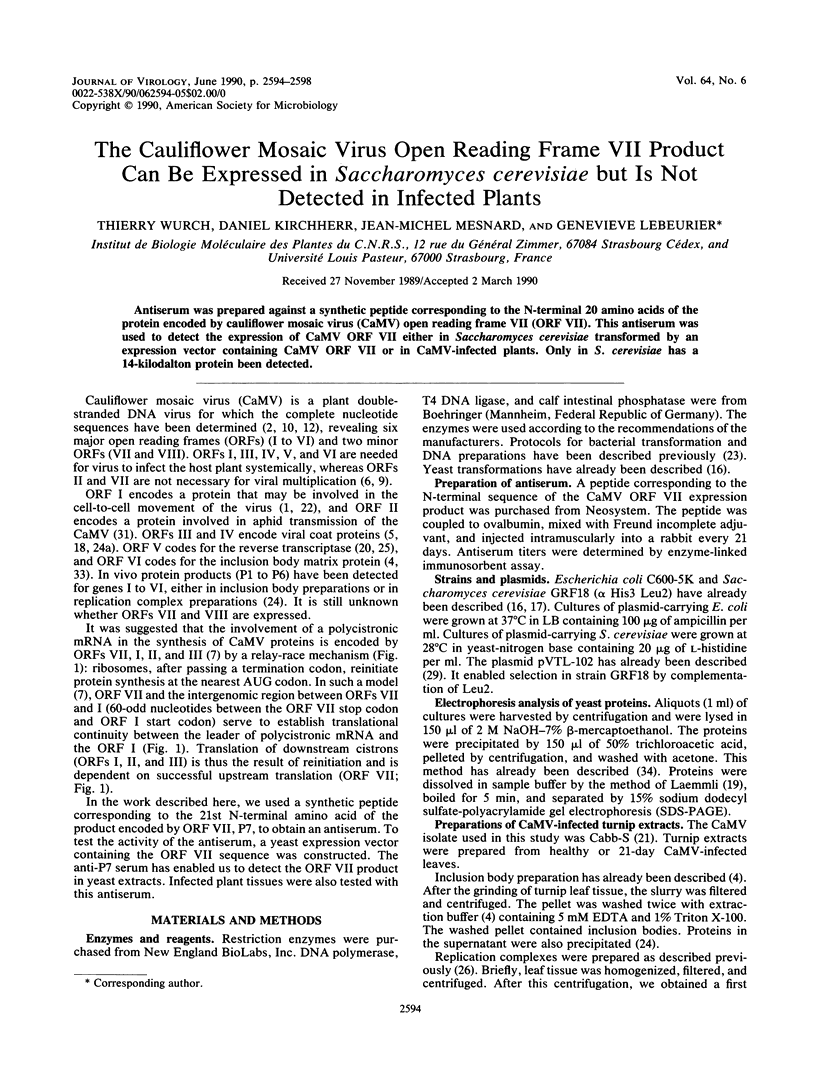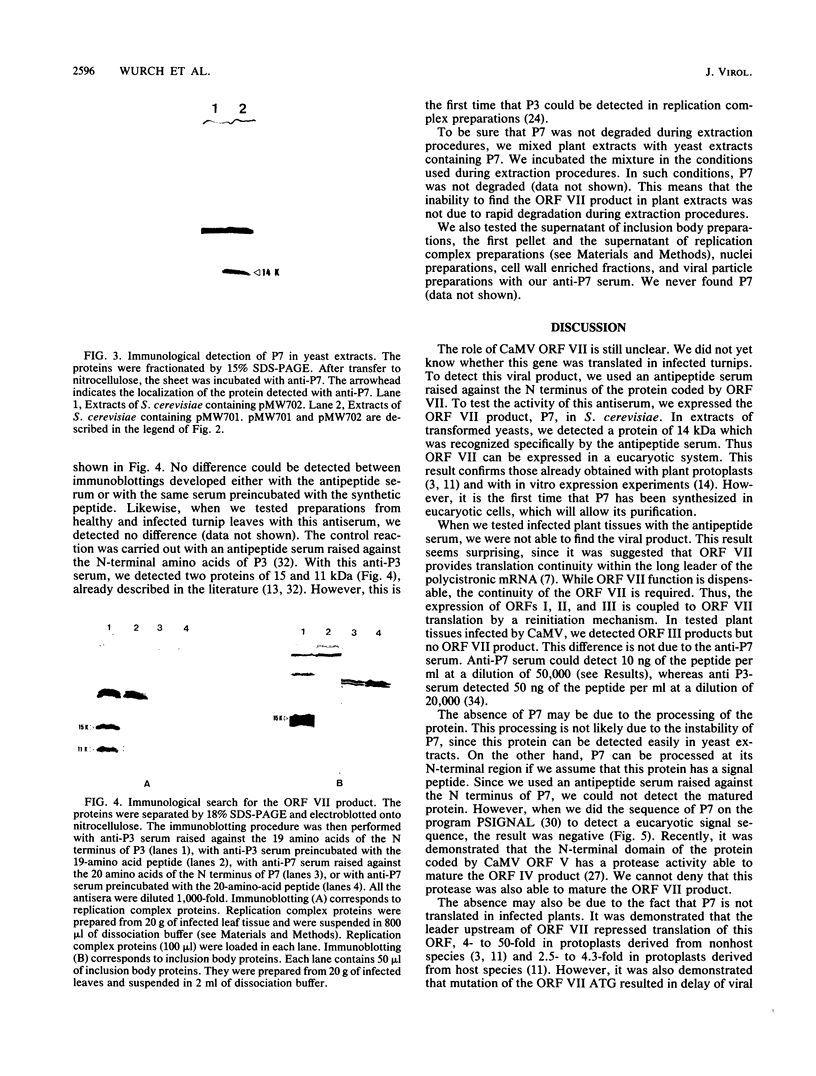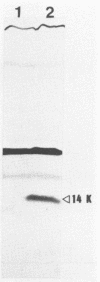Abstract
Antiserum was prepared against a synthetic peptide corresponding to the N-terminal 20 amino acids of the protein encoded by cauliflower mosaic virus (CaMV) open reading frame VII (ORF VII). This antiserum was used to detect the expression of CaMV ORF VII either in Saccharomyces cerevisiae transformed by an expression vector containing CaMV ORF VII or in CaMV-infected plants. Only in S. cerevisiae has a 14-kilodalton protein been detected.
Full text
PDF




Images in this article
Selected References
These references are in PubMed. This may not be the complete list of references from this article.
- Albrecht H., Geldreich A., de Murcia J. M., Kirchherr D., Mesnard J. M., Lebeurier G. Cauliflower mosaic virus gene I product detected in a cell-wall-enriched fraction. Virology. 1988 Apr;163(2):503–508. doi: 10.1016/0042-6822(88)90291-7. [DOI] [PubMed] [Google Scholar]
- Balàzs E., Guilley H., Jonard G., Richards K. Nucleotide sequence of DNA from an altered-virulence isolate D/H of the cauliflower mosaic virus. Gene. 1982 Oct;19(3):239–249. doi: 10.1016/0378-1119(82)90013-0. [DOI] [PubMed] [Google Scholar]
- Baughman G., Howell S. H. Cauliflower mosaic virus 35 S RNA leader region inhibits translation of downstream genes. Virology. 1988 Nov;167(1):125–135. doi: 10.1016/0042-6822(88)90061-x. [DOI] [PubMed] [Google Scholar]
- Daubert S., Shepherd R. J., Gardner R. C. Insertional mutagenesis of the cauliflower mosaic virus genome. Gene. 1983 Nov;25(2-3):201–208. doi: 10.1016/0378-1119(83)90224-x. [DOI] [PubMed] [Google Scholar]
- Dixon L. K., Hohn T. Initiation of translation of the cauliflower mosaic virus genome from a polycistronic mRNA: evidence from deletion mutagenesis. EMBO J. 1984 Dec 1;3(12):2731–2736. doi: 10.1002/j.1460-2075.1984.tb02203.x. [DOI] [PMC free article] [PubMed] [Google Scholar]
- Dixon L. K., Koenig I., Hohn T. Mutagenesis of cauliflower mosaic virus. Gene. 1983 Nov;25(2-3):189–199. doi: 10.1016/s0378-1119(83)80001-8. [DOI] [PubMed] [Google Scholar]
- Dixon L., Jiricny J., Hohn T. Oligonucleotide directed mutagenesis of cauliflower mosaic virus DNA using a repair-resistant nucleoside analogue: identification of an agnogene initiation codon. Gene. 1986;41(2-3):225–231. doi: 10.1016/0378-1119(86)90102-2. [DOI] [PubMed] [Google Scholar]
- Franck A., Guilley H., Jonard G., Richards K., Hirth L. Nucleotide sequence of cauliflower mosaic virus DNA. Cell. 1980 Aug;21(1):285–294. doi: 10.1016/0092-8674(80)90136-1. [DOI] [PubMed] [Google Scholar]
- Fütterer J., Gordon K., Pfeiffer P., Sanfaçon H., Pisan B., Bonneville J. M., Hohn T. Differential inhibition of downstream gene expression by the cauliflower mosaic virus 35S RNA leader. Virus Genes. 1989 Sep;3(1):45–55. doi: 10.1007/BF00301986. [DOI] [PubMed] [Google Scholar]
- Gardner R. C., Howarth A. J., Hahn P., Brown-Luedi M., Shepherd R. J., Messing J. The complete nucleotide sequence of an infectious clone of cauliflower mosaic virus by M13mp7 shotgun sequencing. Nucleic Acids Res. 1981 Jun 25;9(12):2871–2888. doi: 10.1093/nar/9.12.2871. [DOI] [PMC free article] [PubMed] [Google Scholar]
- Giband M., Mesnard J. M., Lebeurier G. The gene III product (P15) of cauliflower mosaic virus is a DNA-binding protein while an immunologically related P11 polypeptide is associated with virions. EMBO J. 1986 Oct;5(10):2433–2438. doi: 10.1002/j.1460-2075.1986.tb04518.x. [DOI] [PMC free article] [PubMed] [Google Scholar]
- Gordon K., Pfeiffer P., Fütterer J., Hohn T. In vitro expression of cauliflower mosaic virus genes. EMBO J. 1988 Feb;7(2):309–317. doi: 10.1002/j.1460-2075.1988.tb02814.x. [DOI] [PMC free article] [PubMed] [Google Scholar]
- Guilley H., Richards K. E., Jonard G. Observations concerning the discontinuous DNAs of cauliflower mosaic virus. EMBO J. 1983;2(2):277–282. doi: 10.1002/j.1460-2075.1983.tb01417.x. [DOI] [PMC free article] [PubMed] [Google Scholar]
- Hinnen A., Hicks J. B., Fink G. R. Transformation of yeast. Proc Natl Acad Sci U S A. 1978 Apr;75(4):1929–1933. doi: 10.1073/pnas.75.4.1929. [DOI] [PMC free article] [PubMed] [Google Scholar]
- Hubacek J., Glover S. W. Complementation analysis of temperature-sensitive host specificity mutations in Escherichia coli. J Mol Biol. 1970 May 28;50(1):111–127. doi: 10.1016/0022-2836(70)90108-7. [DOI] [PubMed] [Google Scholar]
- Laemmli U. K. Cleavage of structural proteins during the assembly of the head of bacteriophage T4. Nature. 1970 Aug 15;227(5259):680–685. doi: 10.1038/227680a0. [DOI] [PubMed] [Google Scholar]
- Lebeurier G., Whitechurch O., Lesot A., Hirth L. Physical map of DNA from a new cauliflower mosaic virus strain. Gene. 1978 Nov;4(3):213–226. doi: 10.1016/0378-1119(78)90019-7. [DOI] [PubMed] [Google Scholar]
- Maule A. J., Harker C. L., Wilson I. G. The pattern of accumulation of cauliflower mosaic virus-specific products in infected turnips. Virology. 1989 Apr;169(2):436–446. doi: 10.1016/0042-6822(89)90169-4. [DOI] [PubMed] [Google Scholar]
- Mesnard J. M., Kirchherr D., Wurch T., Lebeurier G. The cauliflower mosaic virus gene III product is a non-sequence-specific DNA binding protein. Virology. 1990 Feb;174(2):622–624. doi: 10.1016/0042-6822(90)90118-b. [DOI] [PubMed] [Google Scholar]
- Thomas C. M., Hull R., Bryant J. A., Maule A. J. Isolation of a fraction from cauliflower mosaic virus-infected protoplasts which is active in the synthesis of (+) and (-) strand viral DNA and reverse transcription of primed RNA templates. Nucleic Acids Res. 1985 Jun 25;13(12):4557–4576. doi: 10.1093/nar/13.12.4557. [DOI] [PMC free article] [PubMed] [Google Scholar]
- Torruella M., Gordon K., Hohn T. Cauliflower mosaic virus produces an aspartic proteinase to cleave its polyproteins. EMBO J. 1989 Oct;8(10):2819–2825. doi: 10.1002/j.1460-2075.1989.tb08428.x. [DOI] [PMC free article] [PubMed] [Google Scholar]
- Towbin H., Staehelin T., Gordon J. Electrophoretic transfer of proteins from polyacrylamide gels to nitrocellulose sheets: procedure and some applications. Proc Natl Acad Sci U S A. 1979 Sep;76(9):4350–4354. doi: 10.1073/pnas.76.9.4350. [DOI] [PMC free article] [PubMed] [Google Scholar]
- Vernet T., Dignard D., Thomas D. Y. A family of yeast expression vectors containing the phage f1 intergenic region. Gene. 1987;52(2-3):225–233. doi: 10.1016/0378-1119(87)90049-7. [DOI] [PubMed] [Google Scholar]
- Xiong C., Lebeurier G., Hirth L. Detection in vivo of a new gene product (gene III) of cauliflower mosaic virus. Proc Natl Acad Sci U S A. 1984 Nov;81(21):6608–6612. doi: 10.1073/pnas.81.21.6608. [DOI] [PMC free article] [PubMed] [Google Scholar]
- Xiong C., Muller S., Lebeurier G., Hirth L. Identification by immunoprecipitation of cauliflower mosaic virus in vitro major translation product with a specific serum against viroplasm protein. EMBO J. 1982;1(8):971–976. doi: 10.1002/j.1460-2075.1982.tb01280.x. [DOI] [PMC free article] [PubMed] [Google Scholar]
- Yaffe M. P., Schatz G. Two nuclear mutations that block mitochondrial protein import in yeast. Proc Natl Acad Sci U S A. 1984 Aug;81(15):4819–4823. doi: 10.1073/pnas.81.15.4819. [DOI] [PMC free article] [PubMed] [Google Scholar]
- von Heijne G. A new method for predicting signal sequence cleavage sites. Nucleic Acids Res. 1986 Jun 11;14(11):4683–4690. doi: 10.1093/nar/14.11.4683. [DOI] [PMC free article] [PubMed] [Google Scholar]




